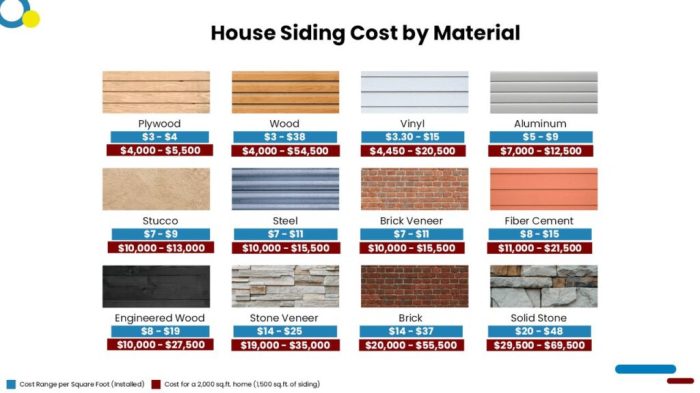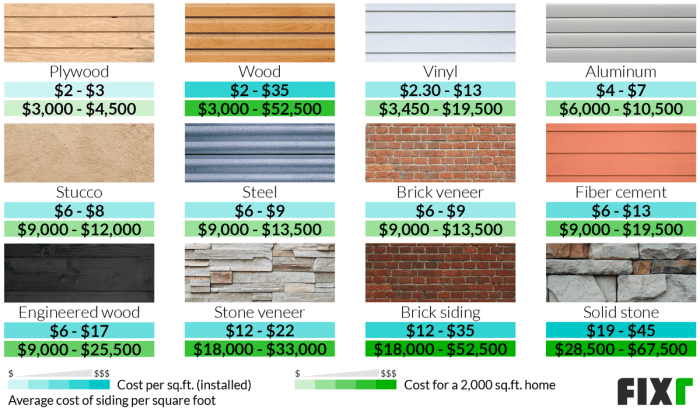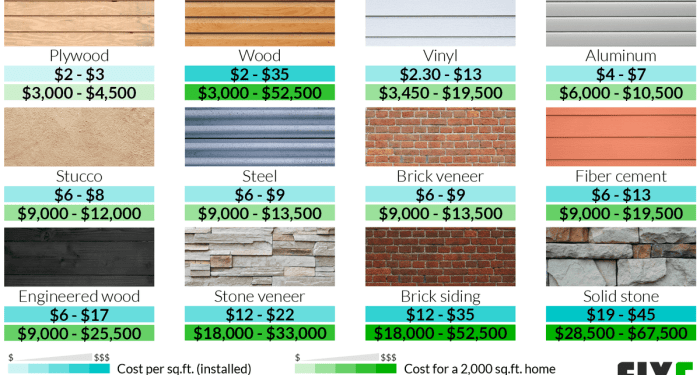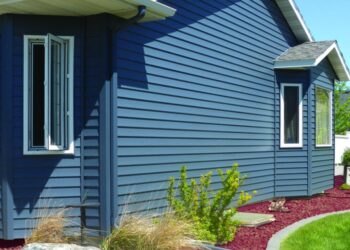Delving into the realm of siding installation cost, this guide aims to provide a detailed insight into the various factors influencing pricing and ways to optimize expenses. From material choices to hidden costs, this exploration will equip you with the knowledge needed to navigate the world of siding installations with confidence.
Factors influencing siding installation cost
When it comes to the cost of siding installation, several factors come into play that can influence the overall price. Understanding these factors can help you make informed decisions about your siding project.
Types of siding materials and their cost variations
Different types of siding materials come with varying costs. For example, vinyl siding is generally more affordable compared to fiber cement or wood siding. The material you choose will have a significant impact on the overall cost of installation.
Size of the house
The size of your house will also affect the cost of siding installation. Larger houses require more materials and more labor, resulting in higher installation costs. It's essential to consider the square footage of your home when estimating the overall expense.
Complexity of the installation job
The complexity of the installation job can also impact pricing. If your house has unique architectural features, intricate designs, or requires additional preparation work, the installation costs may increase. Simple, straightforward installations tend to be more cost-effective.
DIY installation vs. professional installation
Deciding between DIY installation and hiring a professional can also affect the overall cost. While DIY may seem more budget-friendly upfront, mistakes can lead to additional expenses. Professional installers have the experience and tools to complete the job efficiently, potentially saving you money in the long run.
Average cost breakdown of siding installation
When it comes to the average cost breakdown of siding installation, there are several key factors to consider. Understanding how costs are divided can help homeowners better plan and budget for their project.
Cost Breakdown
| Cost Category | Average Percentage of Total Cost |
|---|---|
| Materials | 50% |
| Labor | 40% |
| Permits | 5% |
| Additional Costs | 5% |
Additional costs that homeowners might overlook include disposal fees for old siding, equipment rental costs, and any structural repairs that may be necessary before installation. These costs can add up quickly and should be factored into the overall budget.Location and regional pricing differences can also have a significant impact on the overall cost of siding installation.
Areas with higher costs of living or higher demand for construction services may see higher prices for materials and labor.The quality of materials chosen for the siding can also influence the cost. Higher quality materials may come with a higher price tag upfront but can offer greater durability and longevity, potentially saving homeowners money in the long run through reduced maintenance and replacement costs.
Ways to reduce siding installation costs

When it comes to siding installation costs, there are several strategies you can implement to help reduce the overall expenses and stay within your budget. From negotiating with contractors to choosing cost-effective materials, here are some tips to consider:
Negotiate with contractors for better pricing
One effective way to reduce siding installation costs is by negotiating with contractors to get a better deal. Be upfront about your budget and see if there is room for adjustments in the pricing. Sometimes, contractors may be willing to offer discounts or adjust their rates to accommodate your financial constraints.
Benefits of getting multiple quotes for the project
Before settling on a contractor, it's essential to obtain multiple quotes for the siding installation project. This allows you to compare prices, services, and materials offered by different contractors, giving you a better understanding of the market rates. By gathering multiple quotes, you can choose the most cost-effective option without compromising on quality.
Cost-effective siding materials without compromising quality
Choosing the right siding material is crucial in reducing installation costs without sacrificing quality. Opt for durable yet affordable materials that require minimal upkeep and maintenance. Vinyl and fiber cement siding are popular choices for cost-effective options that offer longevity and aesthetic appeal at a reasonable price.
Proper maintenance to reduce long-term costs
Regular maintenance of your siding can help prevent costly repairs and replacements in the long run. Simple tasks such as cleaning, painting, and inspecting for damages can extend the lifespan of your siding and minimize the need for major renovations.
By investing time and effort in proper maintenance, you can significantly reduce long-term siding installation costs.
Hidden costs to consider during siding installation
When budgeting for siding installation, it's crucial to account for potential hidden costs that may arise throughout the process. These unexpected expenses can impact your overall budget and planning, so being prepared is key to a successful project.
Unforeseen Structural Issues
During the installation process, contractors may uncover underlying structural issues that need to be addressed before the siding can be properly installed. This could include rotting wood, mold, or water damage, which will require additional repairs and costs.
Permit Fees
Depending on your location, you may need to obtain permits for siding installation. These permit fees can vary and should be factored into your overall budget to avoid any surprises during the project.
Trim Work and Customizations
If you want to add custom trim work or unique features to your siding, this can increase the overall cost of the installation. Discussing these options with your contractor upfront and understanding the associated costs can help you budget accordingly.
Weather Delays
Weather delays can prolong the installation process, leading to additional labor costs and potential rescheduling fees. It's important to account for weather-related setbacks in your budget to avoid any financial strain.
Waste Removal
Proper disposal of old siding and construction waste is often an overlooked cost. Ensure that your contractor includes waste removal in their quote or budget separately for this service to avoid any unexpected expenses.
Additional Labor or Materials
In some cases, unforeseen circumstances may require additional labor or materials to complete the siding installation. Having a contingency fund set aside for these unexpected costs can help prevent budget overruns.
Contingency Fund
To prepare for any hidden costs that may arise during siding installation, it's recommended to set aside a contingency fund of about 10-20% of your total project budget. This buffer can help cover any unexpected expenses and ensure that your project stays on track financially.
Closing Summary

In conclusion, understanding the intricacies of siding installation cost is key to making informed decisions for your home improvement projects. By being aware of the influencing factors, average breakdowns, cost reduction strategies, and hidden expenses, you can embark on your siding installation journey with preparedness and clarity.
Popular Questions
What factors can impact siding installation cost?
Factors like the type of siding material, house size, complexity of the job, and DIY vs. professional installation can all influence the overall cost.
How can I reduce siding installation costs?
You can negotiate with contractors, seek multiple quotes, opt for cost-effective materials, and maintain your siding properly to reduce long-term expenses.
Are there hidden costs to consider during siding installation?
Yes, additional charges, budgeting for unexpected expenses, common issues leading to cost overruns, and preparing for unforeseen costs are all important factors to consider.















